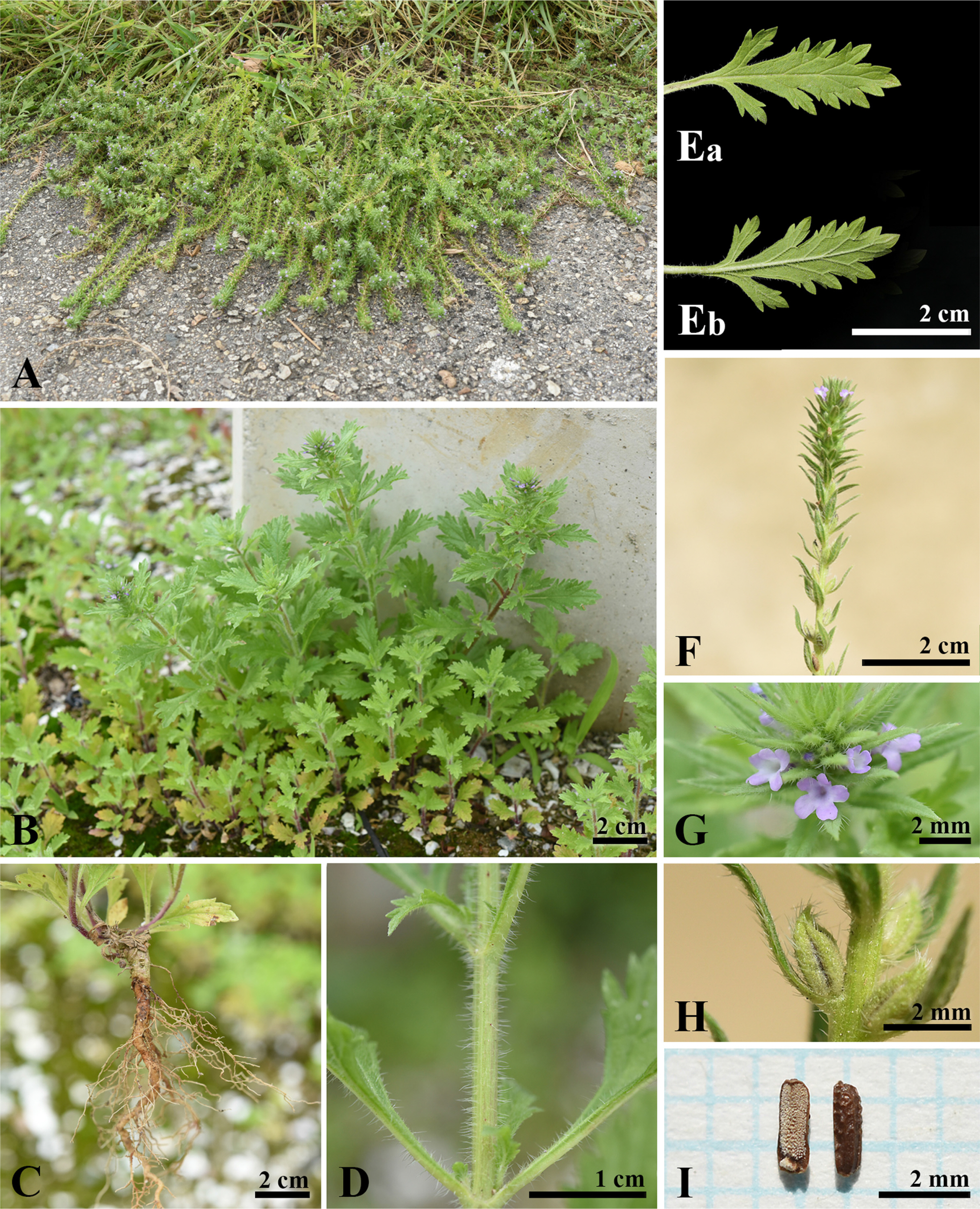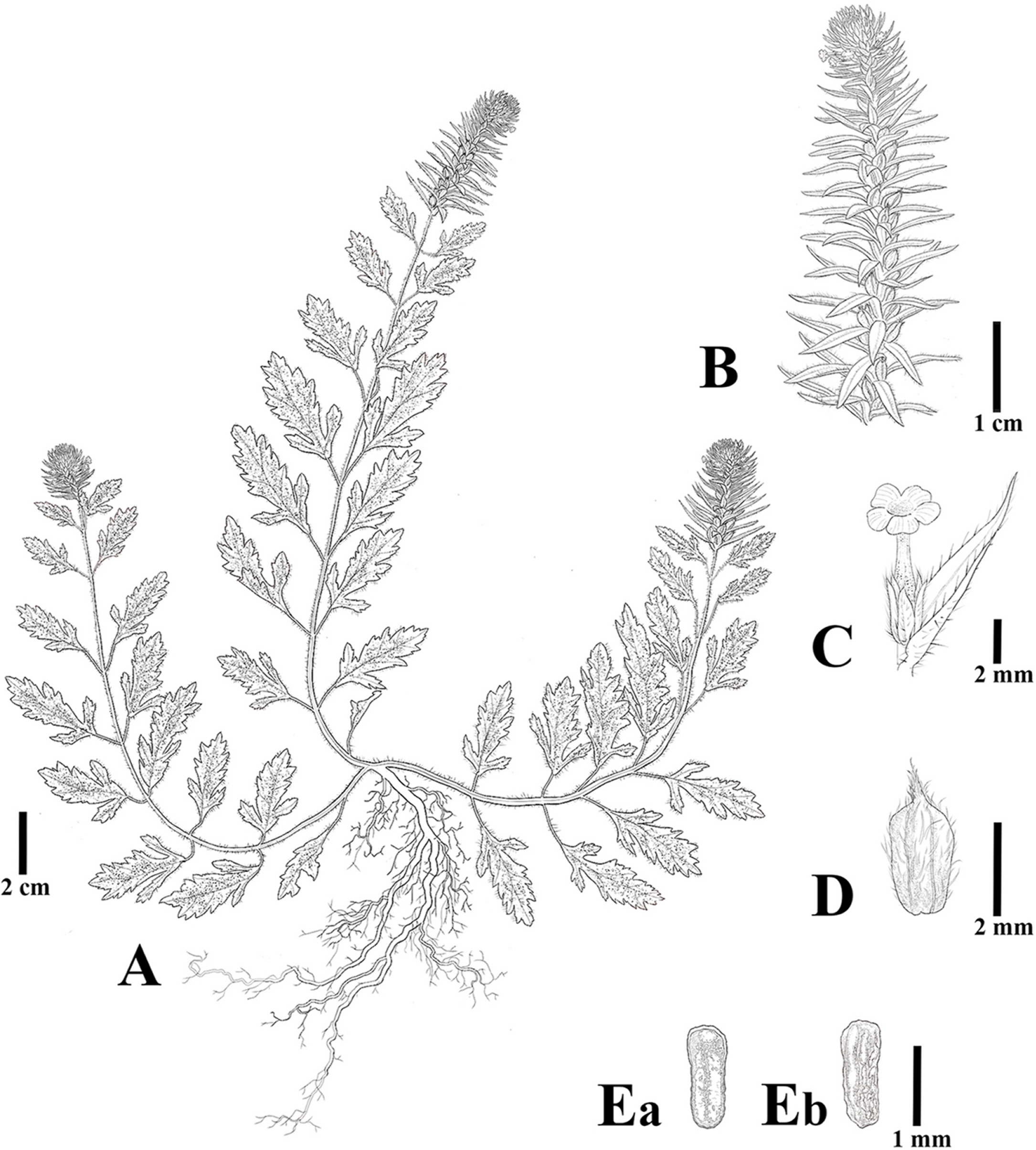/home/virtual/kjpt/journal//../xmls/kjpt-52-3-196.xml
KIM, SHIM, CHO, KIM, HYUN, and PARK: New record of an alien plant, Verbena bracteata (Verbenaceae) in Korea
Abstract
Verbena bracteata Cav. ex Lag. & Rodr. (Verbenaceae), native to North America and an alien plant in China and Japan, was newly found in central and southern areas of Korea. This species can be distinguished from other Verbena taxa in Korea by having larger floral bracts and stems that are prostrate or procumbent to decumbent-ascending. Verbena bracteata grows in dry and sunny grasslands or along roadsides. A precise description, illustration, photographs, and a key to related taxa are provided.
Keywords: alien plant, new record, North America, Verbena bracteata, Verbenaceae
INTRODUCTION
Verbenaceae J. St.-Hil., including approximately 800 species in about 32 genera ( Cardoso et al., 2021), is mainly distributed in tropical and subtropical regions, particularly in southeast Asia, Central and South America, and the West Indies, with few species occurring in the temperate zones ( Sanders, 2001; Marx et al., 2010; Olmstead, 2013; Frost et al., 2017). There are approximately nine species of Verbenaceae belonging to five genera in Korea ( Im, 2018; Kim, 2018).
Verbena L. was originally described by Linnaeus (1753) with 14 species. Since then, several authors have worked on Verbena, and today this genus is represented by ca. 57 to 70 species, which are mainly spread in tropical and subtropical countries of America, some of them growing in Asia, Africa, Australia, and Europe ( Perry, 1933; Munir, 2002; O’Leary, 2006; Nesom, 2010a, 2010b, O'Leary et al., 2010; Cardoso et al., 2021; Tunçkol, 2022). The plants are annual and perennial herbs or subshrubs ( Marx et al., 2010). Many Verbena species possess medicinal uses, and some species are of economic importance ( Perry, 1933; Kubica et al., 2020). Recently, morphological data have suggested the infrageneric classification of the genus Verbena with three sections: Verbena, Amphepeiros Nesom, and Verbenaca Walpers ( Nesom, 2010a). The three sections are recognized within Verbena, primarily based on inflorescence structure ( Nesom, 2010a). In Korea, three species in the genus Verbena are reported; V. officinalis L., V. bonariensis L., and V. brasiliensis Vell. ( Kim et al., 2018). Among then, V. officinalis is the only native species in Korea ( Lee, 1980; Lee, 1996; Im, 2018; Kim, 2018), and the other two species are alien species ( Park, 1998; Kil et al., 2001; Kang et al., 2020).
During a plant diversity field survey in Korean Peninsula, an unrecorded alien plant, Verbena bracteata Cav. ex Lag. & Rodr. was found in abandoned fields and roadsides in Gyeonggi-do and Gyeongsangnam-do, Korea. Verbena bracteata belongs to sect. Verbena. The sect. Verbena comprises ca. 46 species that are mainly distributed in the New World ( Nesom, 2010a). We here formally report the first occurrence of the Verbena bracteata in Korea ( Figs. 1– 3). The Korean name is ‘Gin-po-ma-pyeon-cho’, based on floral bracts much longer than the calyx. We provide a description, illustrations, a taxonomic key to related taxa as well as habitat details.
TAXONOMIC TREATMENT
Verbena bracteata Cav. ex Lag. & Rodr., Anales Ci. Nat. 4: 260, 1801.—TYPE: cult. in SPAIN. without date and collector (holotype: MA, photo!).
Verbena bracteosa Michx., Fl. Bor.-Amer 2: 13, 1803; Zappania bracteosa (Michx.) Poir., in Lamarck, Encycl. 8: 843, 1808.—TYPE: USA. Tennessee, without date, Michaux s.n. (isotype: P, photo!).
Verbena bracteosa var. brevibracteata A. Gray, Sin. Fl. N. Amer. 2: 336, 1878.—TYPE: USA. Texas, 1849, Wright 454 (lectotype: GH, photo!).
Verbena rudis Greene, Pittonia 4: 152, 1899.—TYPE: USA. Colorado, 18 Jun 1899, Baker 564 (holotype: G, photo!).
Verbena bracteosa var. albiflora Cockerell, in F. P. Daniels, Fl. Boulder 204, 1911.
Verbena imbricata Wooton & Standl., Contr. U. S. Natl. Herb. 16: 166, 1913.—TYPE: USA. New Mexico, 8 Aug 1904, Wooton 2831 (holotype: US; isotype: US, photo!).
Korean name: Gin-po-ma-pyeon-cho (긴포마편초).
Herbs, annual or biennial, 10−30 cm tall. Stems several, prostrate or procumbent to decumbent-ascending, rarely erect, diffusely branched, quadrangular, coarsely hirsute. Leaves opposite, thick membranaceous; petiole 0.3−1.5 cm long, winged or widely margined, hirsute, upper leaves subsessile; blade lanceolate to ovate-lanceolate or oblanceolate, 1−5 cm long, pinnately incised or usually 3-lobed, lateral lobes narrow or divaricate, middle lobes cuneate-obovate, incisely toothed or cleft, narrowed into a short margined petiole, hirsute on both surfaces. Inflorescences terminal, usually solitary, spikes, slender, 2–20 cm long, bracts linear-lanceolate, acuteacuminate, entire; 8−15 mm long, 2–4 times as long as the calyx, hirsute. Flowers zygomorphic; calyx 3–4 mm long, 5-lobed, hirsute; corolla pale blue to purplish-blue, narrowly funnelform to somewhat trumpet-shaped, 4–6 mm long, 5-lobed, glabrous, tube relatively slender, limb 2–3 mm in diam.; stamens 4, didynamous; filaments short, anthers yellow, 0.2 mm long; pistil 1, ovary superior, 2 carpels, 4-lobed; style short. Fruit schizocarps, oblong, 2–2.5 mm long.
Flowering: June to August.
Fruiting: August to October.
Distribution and habitat: Verbena bracteata is native to North America, whereas this species is non-native in China, Japan, and Korea ( Shimizu, 2003; Mito and Uesugi, 2004; Wang et al., 2005). Two populations, each containing ca. 300 to 1,000 individuals, are found in open habitats, dry and sunny grasslands, or roadsides on lowlands. It grows together with herbaceous plants such as Humulus japonicas Siebold & Zucc., Phytolacca americana L., Portulaca oleracea L., Persicaria lapathifolia (L.) Delarbre, Polygonum aviculare L., Lepidium densiflorum Schrad., Potentilla supina L., Oenothera biennis L., Euphorbia hypericifolia L., Euphorbia maculata L., Oxalis dillenii Jacq., Metaplexis japonica (Thunb.) Makino, Ipomoea lacunosa L., Plantago lanceolata L., Veronica arvensis L., Artemisia indica Willd., Aster pilosus Willd., Bidens frondosa L., Bidens pilosa L., Conyza canadensis (L.) Cronquist, Conyza sumatrensis (Retz.) E. Walker, Erigeron annuus (L.) Pers., Lactuca indica L., Lactuca scariola L., Sonchus asper (L.) Hill, Tragopogon dubius Scop., Commelina communis L., Digitaria ciliaris (Retz.) Koeler, Elymus ciliaris (Trin.) Tzvelev, Eragrostis minor Host, Festuca arundinacea Schreb ., Poa annua L., and Setaria viridis (L.) P. Beauv.
Specimens examined: KOREA. Gyeonggi-do: Incheon-si, Bupyeong-gu, San-gok-dong, 3 Aug 2021, Jung-Hyun Kim KIMJH21108, KIMJH21109, KIMJH21110, KIMJH21111, KIMJH21112 (KB), Jin Hee Park, Jung-Hyun Kim & Kyu Tae Cho Park et al. 20210803-1-1 (NNIBRVP99285), Park et al. 20210803-1-2 (NNIBRVP99286), Park et al. 20210803-1-3 (NNIBRVP99287), Park et al. 20210803-1-4 (NNIBRVP99288), Park et al. 20210803-1-5 (NNIBRVP99289), Park et al. 20210803-2-1 (NNIBRVP99290), Park et al. 20210803-2-2 (NNIBRVP99291), Park et al. 20210803-2-3 (NNIBRVP99292), Park et al. 20210803-2-4 (NNIBRVP99293), Park et al. 20210803-2-5 (NNIBRVP99294), Park et al. 20210803-2-6 (NNIBRVP99295), Park et al. 20210803-2-7 (NNIBRVP99296), Park et al. 20210803-2-8 (NNIBRVP99297), Park et al. 20210803-2-9 (NNIBRVP99298), Park et al. 20210803-2-10 (NNIBRVP99299), Park et al. 20210803-2-11(NNIBRVP99300), Park et al. 20210803-2-12 (NNIBRVP99301), Park et al. 20210803-2-13 (NNIBRVP99302), Park et al. 20210803-2-14 (NNIBRVP99303), Park et al. 20210803-2-15 (NNIBRVP99304), Park et al. 20210803-3-1 (NNIBRVP99305), Park et al. 20210803-3-2 (NNIBRVP99306), Park et al. 20210803-3-3 (NNIBRVP99307), Park et al. 20210803-3-4 (NNIBRVP99308), Park et al. 20210803-3-5 (NNIBRVP99309) (NNH); same locality, 5 Oct 2021, Jin Hee Park & Kyu Tae Cho Park JH & Cho KT 20211005-1-1 (NNIBRVP99310), Park JH & Cho KT 20211005-1-2 (NNIBRVP99311), Park JH & Cho KT 20211005- 1-3 (NNIBRVP99312), Park JH & Cho KT 20211005-2-1 (NNIBRVP99313), Park JH & Cho KT 20211005-2-2 (NNIBRVP99314), Park JH & Cho KT 20211005-2-3 (NNIBRVP99315), Park JH & Cho KT 20211005-3-1 (NNIBRVP99316), Park JH & Cho KT 20211005-3-2 (NNIBRVP99317), Park JH & Cho KT 20211005-4-1 (NNIBRVP99318), Park JH & Cho KT 20211005-4-2 (NNIBRVP99319) (NNH). Gyeongsangnam-do: Tongyeong-si, Dosan-myeon, Doseon-ri, 10 Aug 2019, Hyun Sik Kim & Sang Deog Shim KIMJH19233, KIMJH19234 (KB); same locality, 17 Jun 2021, Jung-Hyun Kim & Seog woo Kwon KIMJH21102, KIMJH21103, KIMJH21104, KIMJH21105, KIMJH21106, KIMJH21107 (KB); same locality, 22 Jun 2022, Jung-Hyun Kim KIMJH22048, KIMJH22049, KIMJH22050 (KB).
A key to Verbena and related taxa in Korea
1. Stem prostrate or procumbent to decumbent-ascending; bracts much longer than the calyx ································· ················································· V. bracteata 긴포마편초 1. Stem erect; bracts shorter than or about equaling to calyx.
ACKNOWLEDGMENTS
This work was supported by a grants from the National Institute of Biological Resources (NIBR) and Nakdonggang National Institute of Biological Resources (NNIBR), funded by the Ministry of Environment (MOE) of the Republic of Korea (NIBR202203102 and NNIBR202201102).
Fig. 1.
Photographs of Verbena bracteata Cav. ex Lag. & Rodr. A. Habitat. B. Habit. C. Root. D. Stem. E. Leaves (a, adaxial view; b, abaxial view). F. Spike. G. Flower. H. Schizocarp. I. Mericarps (abaxial and adaxial views). 
Fig. 2.
Illustrations of Verbena bracteata Cav. ex Lag. & Rodr. A. Habit. B. Spike. C. Flower with calyx and bract. D. Schizocarp. E. Mericarps (a, abaxial view; b, adaxial view). 
Fig. 3.
Distribution of Verbena bracteata Cav. ex Lag. & Rodr. in Korea. 
LITERATURE CITED
Cardoso, PH. O’Leary, N. Olmstead, RG. Moroni, P and Thode, VA. 2021. An update of the Verbenaceae genera and species numbers. Plant Ecology and Evolution 154: 80-86.   Im, H-T. 2018. Verbenaceae J. St.-Hil. In Flora of Korea. 6a: Asteridae: Loganiaceae to Oleaceae. Flora of Korea Editorial Committee (ed.), National Institute of Biological Resources, Incheon. 71-77.
Kang, ES. Lee, S-R. Oh, SH. Kim, D-K. Jung, S-Y and Son, DC. 2020. Comprehensive review about alien plants in Korea. Korean Journal of Plant Taxonomy 50: 89-119 (in Korean).   Kil, J-H. Suh, M-H and Park, S-H. 2001. Unrecorded and naturalized plants in Korea (XVII). Korean Journal of Plant Taxonomy 31: 375-382 (in Korean).
Kim, H. 2018. Verbenaceae J. St.-Hil. The Genera of Vascular Plants of Korea. Flora of Korea Editorial Committee (ed.), Hongreung Publishing Company, Seoul. 1071-1080 (in Korean).
Kim, JS. Kim, JH and Kim, JH. 2018. Herbaceous Plants of Korean Peninsula I. Plants Living in Seasides, Rivers, Wetlands and Cities. Dolbegae, Paju. 657 (in Korean).
Kubica, P. Szopa, A. Dominiak, J. Luczkiewicz, M and Ekiert, H. 2020.
Verbena officinalis (common Vervain): A review on the investigations of this medicinally important plants species. Planta Medica 86: 1241-1257.  Lee, TB. 1980. Illustrated Flora of Korea. Hyangmunsa, Seoul. 990 (in Korean).
Lee, WT. 1996. Coloured Standard Illustrations of Korean Plants. Academy Publishing Co, Seoul. 624 (in Korean).
Linnaeus, C von. 1753. Species Plantarum. 1: Laurentius Salvius, Holmiae. 18-21.
Mito, T and Uesugi, T. 2004. Invasive alien species in Japan: The status quo and the new regulation for prevention of their adverse effects. Global Environmental Research 8: 171-191.
Munir, AA. 2002. A taxonomic revision of the genus Verbena L. (Verbenaceae) in Australia. Journal of the Adelaide Botanical Garden 18: 21-103.
Nesom, GL. 2010a. Infrageneric classification of Verbena (Verbenaceae). Phytoneuron 2010–11: 1-5.
Nesom, GL. 2010b. Revision of Verbena ser. Tricesimae (Verbenaceae). Phytoneuron 2010–35: 1-38.
Olmstead, RG. 2013. Phylogeny and biogeography in Solanaceae, Verbenaceae and Bignoniaceae: A comparison of continental and intercontinental diversification patterns. Botanical Journal of the Linnean Society 171: 80-102.  O’Leary, N. 2006. Typifications in Verbena (Verbenaceae). Darwiniana 44: 493-499.
O’Leary, N. Múlgura, ME and Morrone, O. 2010. Revisión taxonómica de las especies of del género Verbena (Verbenaceae). II: Serie Verbena
. Annals of the Missouri Botanical Garden 97: 365-424.  Park, SH. 1998. Unrecorded naturalized plants in Korea (XIII). Korean Journal of Plant Taxonomy 28: 415-425 (in Korean).
Perry, LM. 1933. A revision of the North American species of Verbena
. Annals of the Missouri Botanical Garden 20: 239-362.  Sanders, RW. 2001. The genera of Verbenaceae in the southeastern United States. Harvard Papers in Botany 5: 303-358.
Shimizu, T. 2003. Naturalized Plants of Japan. Heibonsha Ltd, Tokyo. 337 (in Japanese).
Tunçkol, B. 2022.
Verbena brasiliensis Vell.: A new record of an invasive alien species in the flora of Turkey. BioInvasions Records 11: 57-61.  Wang, Q. Li, Y and Chen, C. 2005. A newly recorded species of Verbena Linn. in China. Chinese Bulletin of Botany 22: 32-34 (in Chinese).
|
|














